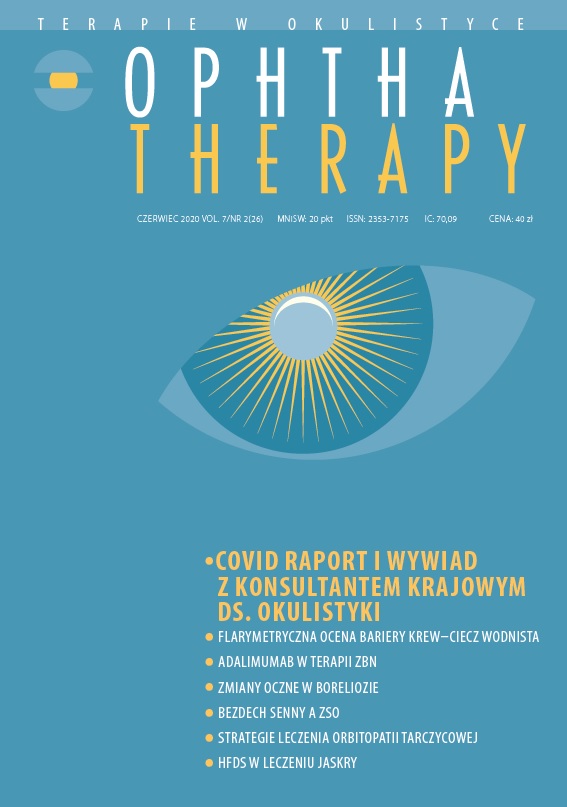Perspectives of clinical applications of RENEXUS® implants in macular telangiectasia type 2 Review article
Main Article Content
Abstract
The intraocular RENEXUS® implant, manufactured by Neurotech Pharmaceuticals, represents a new-generation ophthalmic product with regard to its active chemical substance and mode of the intraocular delivery system. The active compound of the implant, ciliary neurotrophic factor (CNTF), is produced by human retinal pigment epithelium cells that are encapsulated within the device. Ciliary neurotrophic factor has protective effects on retinal cells that help delay their degeneration in chronic retinal degenerative disorders and cases of prolonged ischemia. RENEXUS® implants may be useful for the treatment of macular telangiectasia type 2, retinitis pigmentosa, glaucoma, neuropathy, anterior ischemic neuropathy, and age-related macular degeneration. The active time of CNTF secretion after implantation is approximately 5 years.
Intraocular RENEXUS® implants were evaluated in a Phase II clinical trial and have now been tested in a double-blind placebo-controlled clinical trial of macular telangiectasia type 2.
Downloads
Article Details

This work is licensed under a Creative Commons Attribution-NonCommercial-NoDerivatives 4.0 International License.
Copyright: © Medical Education sp. z o.o. License allowing third parties to copy and redistribute the material in any medium or format and to remix, transform, and build upon the material, provided the original work is properly cited and states its license.
Address reprint requests to: Medical Education, Marcin Kuźma (marcin.kuzma@mededu.pl)
References
2. Adler R, Landa KB, Manthorpe M et al. Cholinergic neurotrophic factors: intraocular distribution of soluble trophic activity for ciliary neurons. Science. 1979; 204: 1434-6.
3. Yu S, Tanabe T, Yoshimura N. A rat model of glaucoma induced by episcleral vein ligation. Exp Eye Res. 2006; 83(4): 758-70.
4. Valter K, Bisti S, Gargini C et al. Time course of neurotrophic factor upregulation and retinal protection against light-induced damage after optic nerve section. Invest Ophthalmol Vis Sci. 2005; 46(5): 1748-54.
5. Sieving PA, Caruso RC, Tao W et al. Ciliary neurotrophic factor (CNTF) for humar retinal degeneration:phase I trial of CNTF delivered by encapsulated cell intraocular implants. Proc Natl Acord Sci USA. 2006; 103: 3896-901.
6. Jaffe GJ, Tao W, Group CS. A Phase 2 study of encapsulated CNTF-secreting cell implant (NT-501) in patients with geographic atrophy associated with dry AMD-18 month results. Presented at the Association for Research in Vision and Ophthalmology Annual Meeting. May 2005, Fort Lauderdale, FL.
7. Zhang K, Hopkins JJ, Heier JS et al. Ciliary neurotrophic factor delivered by encapsulated cell intraocular implants for treatment of geographic atrophy in age-related macular degeneration. Proc Natl Acad Sci USA. 2011; 108: 6241-5.
8. Talcott KE, Ratnam K, Sundquist SM et al. Longitudinal study of cone photoreceptors during retinal degeneration and in response to ciliary neurotrophic factor treatment. Invest Ophthalmol Vis Sci. 2011; 52: 2219-26.
9. Gass JD, Oyakawa RT. Idiopathic juxtafoveolar retinal telangiectasis. Arch Ophthalmol. 1982; 100: 769-80.
10. Charbel Issa P, Gilles MC, Chew EY et al. Macular telangiectasia type 2. Prog Retin Eye Res. 2013; 34: 49-77.
11. Davidoff FH, Pressman HD, Chambers RB. Juxtafoveal telangiectasia name change? Retina. 2004; 24: 474-8.
12. Powner MB, Giliies MC, Zhu M et al. Loss of Muller cells and photoreceptors in macular telangiectasia type 2. Ophthalmology. 2013; 120: 2344-52.
13. Engelbrecht NE, Aaberg TM Jr, Sung J et al. Neovascular membranes associated with idiopathic juxtafoveolar telangiectasia. Arch Opthalmol. 2020; 102: 320-4.
14. Chew EY, Clemons TE, Jaffe GJ et al. Effect of Cliliary Neurotrophic Factor on Retinal Neurodegeneration in Patients With Macular Telangiectasia Type 2. Arandomized Clinal Trial. Ophthalmology. 2019; 126(4): 540-9.

